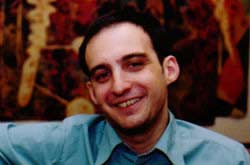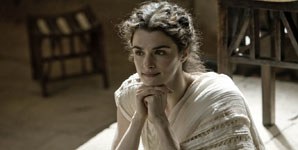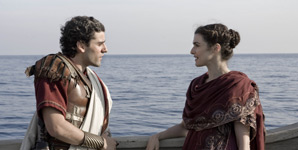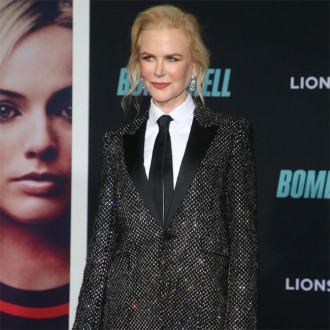
Alejandro Amenabar Interview
07 January 2009Talented young Spanish director Alejandro Amenábar connects with Cruise and Kidman for his US debut
Writer-director Alejandro Amenábar first caught the imagination of the Spanish public in 1996 with his film debut entitled "Tésis" ("Thesis" in the US), a thriller about a cinematography student whose life is put in danger when she stumbles upon a snuff film buried in her campus film archive.
A year later he released a brilliant psychological thriller with a shocking twist ending called "Abre los Ojos" ("Open Your Eyes"). The story of a rich, young Don Juan whose mind and body are warped in a car accident, it became one of the highest grossing films in Spanish history and was nominated for 10 Goya awards -- that country's Oscar.
In 1999, "Open Your Eyes" played on a few screens in the United States (it was No. 2 on my top 10 list that year), but it never found an audience, making less that $400,000. However, the picture did find one important fan with a whole lot of clout in Hollywood. Tom Cruise, who was starring in "Eyes Wide Shut" at the time, bought the rights to remake the film and began a partnership with 29-year-old Amemábar that has spawned two major motion pictures in 2001.
Cruise is starring in the "Open Your Eyes" remake -- entitled "Vanilla Sky" and directed by Cameron Crowe ("Almost Famous") -- which is due in December. And Amemábar is making his English language debut with "The Others," which opens this weekend in American theaters nationwide.
A bone-chilling revival of the old-school haunted house movie with another Amenábar shock ending (he has a penchant toward such surprises), "The Others" was produced by Cruise and stars his then-wife Nicole Kidman in an outstanding performance as a skittish 1940s mother trapped in her ghostly island mansion because her children are fatally allergic to sunlight. Cut off from the outside world (cars and telephones haven't been returned to service on the island after World War II), she spends her days obsessed with protecting the children, closing heavy curtains and locking doors of any room they enter to prevent even a sliver of light from invading. But when the house seized by spirits that begin tearing down those curtains and flinging open doors, it puts their lives in danger -- and that's just the beginning.
Short, lanky, incredibly soft-spoken (but with very good English) and sporting a friendly, lop-sided smile, Amenábar doesn't look like a guy who spends much time in the darker recesses of his mind. But with pictures like "Thesis," "Open Your Eyes" and "The Others" floating around in his cerebellum (he wrote, directed and scored the soundtrack for all three) there was obviously more going on than meets the eye when we sat down to talk over coffee a couple weeks ago at Postrio's Restaurant in San Francisco.
| Q: "The Others" has the look of a '30s or '40s haunted house movie. Creaking doors and floorboards, graves next to a craggy dead tree on the grounds of a spooky old mansion. What was the inspiration for the film's visual style? |
A: From the kind of book I used to read as a child. My mother used to take my brother and me to get any books we wanted, but they were second hand books published in the '30s and '40s. I liked scary books that had the kind of drawings I'm trying to recapture in the opening credits. The sensations and feelings I had a s a child is what I tried to get back in this story. Setting the story in the '40s helped me develop it. (I was) trying to get back a kind of fear I can't see usually in the theaters anymore. I wouldn't say this is a horror film, (but) it's a scary film sometimes.
| Q: What I like the most about it is that it's what you don't see that scares you. |
A: Exactly. It's playing with our primal fears -- and that's the darkness, what you see in the shadows. When you see a monster (in a horror movie) it's not creepy anymore, sometimes it's just disgusting. I find it more effecting to use hidden things.
| Q: Tension and terror build so slowly in this film that it actually makes the trepidation grow exponentially. How did you accomplish that? |
A: I would agree with that, but I don't know that it's been accomplished. That's up to the audience. That's the big risk of it. Trying to get the attention of the audience in the opposite way it's done in Hollywood today, which is to bombard the audience. I know that this kind of style will work for me, but you never know if you're going to connect with the rest of the people.
| Q: I like that you had a legitimate reason for constant darkness. How did you hit on the concept of the children being allergic to sunlight? |
A: This is a metaphor. This is a journey for Grace and her children towards light and discovery. Brightness is knowledge and in this case the darkness is a metaphor. This woman is blinded by her beliefs and the way she teaches her belief. In the film she begins to open her mind and open to the light.
| Q: You delve deeply into the psychology of the characters in this film -- into Grace's stress, her state of turmoil. |
A: To me it's a very interesting thing to explore the minds of the characters. Especially for Nicole. She added things to the character and made her more complex. To have an impact for the audience, to get connection to the audience -- this shouldn't be through a special effect. It should be through the faces of the actors. That for me is why the psychological aspect is so important.
| Q: Well it works. Let me read you something verbatim from my notes when I saw the film: This movie would be chilling even if you blacked out everything on the screen except Kidman's porcelain face, her eyes frozen wide with fear. |
A: [Smiles appreciatively.] That's the best special effect. When I met Nicole the first time, the first thing that appealed to me and impressed me was her eyes. The director of photography, Javier Aguirresarobe, and I were very, very focused on her eyes. We wanted to see those eyes on the screen. In order to transmit something to the audience we wanted to play with very simple elements. In horror movies today it's lots of fast cut shot and lots of loud noises on the soundtrack. I tried to do the opposite. Playing with silence for instance. Silence is very important in this film.
| Q: You're almost answering my questions before I ask them! The next thing I was going to say was another quote from my notes: The scariest parts have no score, and they're scarier because of it. |
A: Sometimes a piece of music in the score isn't effective. When a score is too well finished with too many elements, sometimes it's too much.
| Q: Why did you decide to score the movie yourself? |
A: If I chose someone else to do it , I would be such a pain in the ass. I always see the movie as a director, so as a composer I always feel controlled by the director within me. Sometimes I've taken out pieces of the music from a film. In this film for instance, which has almost one hour of music, I tried to play it in a very, very quiet level. And I tried to score it in two ways -- the horror and the drama. The parts I'm most proud of are the drama parts. My main worry was that the score wouldn't be as good as the other technical aspects of the film.
| Q: What's your musical background? |
A: Mostly listing to soundtracks as a kid. I got hooked on movies after listing to soundtracks -- John Williams, Bernard Herrmann. I ended up doing music for my short films and that led to doing music for my first feature. Every time I tell myself this is the last time I'll do a score for my own film! Many directors say when they watch the movie with the score it's a whole new experience. That doesn't happen to me.
| Q: I don't mind telling you that the servants seem a little clichéd at times: It's hard to take them seriously when they squint spookily and say things like, "All in good time Mr. Tittle, all in good time!" |
A: It's a way to play with the audience. We worked very hard on that. I wanted a second viewing of the film to reveal (that) all the clues would make sense in a different way. In the first viewing you put in the audience in another place. When you see the servants in the first view you see conspiracy and cliché. I think that's one of the secondary plots in the film, the plot of the servants, and it makes sense in the end.
Contactmusic
Top 10 Videos
Wallace Chung
XXX
1
10 Years
Beautiful
2
Fast Girls
Fast Girls
3
Shaggy
Hey Sexy Lady
4
Air
Sexy Boy
5
The Staves
Tired As F***
6
Robin Thicke
Blurred Lines (Unrated Version)
7
All That Remains
Six (Live)
8
Fugees
Boof Baf
9
Fleur East
Sax [Live]
10
Movies and Trailers

Agora Movie Review
Ambitious in scope, this film feels over-serious and oddly cold. Fans of historical dramas may...

Agora Trailer
Set in Alexandria in 391 A.D. Agora tells the story of the astronomer-philosopher Hypatia. Knowing...

